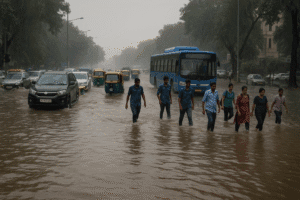Beyond the Puddles: Delhi’s Monsoon Woes Expose Deeper Urban Cracks
Delhi faced severe disruption Monday morning after overnight rains submerged key roads, including Panchkuian Marg, Connaught Place, and Sarojini Nagar. Vehicles struggled through flooded streets, while commuters on the Delhi-Gurugram Expressway waded through knee-deep water, highlighting chronic infrastructure failures. The IMD forecasts continued light rain and drizzle across Delhi-NCR Sunday, extending to Gurugram, Noida, Ghaziabad, and Faridabad.
Though temperatures dipped slightly below seasonal averages (33.7°C max), oppressive 90% humidity offset relief. Positively, air quality remained “satisfactory” (AQI 84). This recurring crisis underscores systemic drainage flaws and urban planning gaps, turning predictable monsoons into annual ordeals that cripple mobility, damage livelihoods, and expose civic vulnerability despite weather warnings.

Beyond the Puddles: Delhi’s Monsoon Woes Expose Deeper Urban Cracks
The familiar rhythm of Delhi’s monsoon played out again overnight: the drumming rain brought respite from oppressive humidity, only to be swiftly followed by the grim spectacle of waterlogged streets grinding the city to a halt. Monday morning dawned on a capital transformed into an archipelago of flooded neighborhoods, from the bustling corridors of Panchkuian Marg to the iconic circles of Connaught Place.
More Than Just Inconvenience:
- Commuter Chaos: Videos captured the stark reality – vehicles reduced to boats navigating submerged roads on Panchkuian Marg, commuters on the Delhi-Gurugram Expressway wading through knee-deep water. Key arteries like Vijay Chowk, Minto Bridge (a notorious perennial flood point), Sarojini Nagar, and near AIIMS became impassable, disrupting countless journeys and livelihoods.
- Systemic Failure Laid Bare: This isn’t merely “heavy rain”; it’s a recurring indictment of Delhi’s fragile urban infrastructure. Inadequate drainage, clogged stormwater systems choked with plastic and construction debris, and unchecked urban sprawl paving over natural recharge zones turn predictable seasonal rain into a recurring disaster. “We see this every year,” laments urban planning expert Dr. Ananya Roy. “The investment in sustainable drainage solutions hasn’t kept pace with the city’s growth or the intensifying monsoon patterns linked to climate change.”
The Forecast: More Rain, More Strain The India Meteorological Department (IMD) offers little immediate reprieve, predicting continued light rain and drizzle across Delhi-NCR throughout Sunday. The threat extends to neighboring hubs:
- Light to Moderate Rain & Thunderstorms: Expected in NCR areas like Bahadurgarh and Manesar.
- Widespread Light Rain: Likely across Ghaziabad (Loni Dehat, Indirapuram), Noida, Greater Noida, Gurugram, Faridabad, and Ballabhgarh.
Silver Linings and Lingering Discomfort: While the rain lowered temperatures (Saturday’s max was 33.7°C, 1.1° below average), high humidity levels (90% recorded Saturday evening) ensured the relief felt muggy and uncomfortable. The one positive note was air quality, remaining in the “Satisfactory” category (AQI 84) amidst the downpour.
Beyond the Headlines: The Human Cost The real story isn’t just the inches of rainfall; it’s the hours lost in traffic, the damaged vehicles, the risk of disease from stagnant water, and the immense hardship for pedestrians and daily wage workers. It’s businesses facing losses and emergency services struggling to navigate flooded streets. This annual cycle erodes quality of life and highlights a critical governance gap.
Staying Prepared: With more rain forecast, Delhi residents are advised to:
- Check Routes: Avoid known waterlogging hotspots like Minto Bridge, underpasses, and low-lying areas. Use real-time traffic apps.
- Exercise Caution: Never drive or walk through deep, fast-moving water. Beware of submerged potholes and open manholes.
- Stay Informed: Monitor IMD updates and local news for weather alerts and traffic disruptions.
- Emergency Numbers: Keep local civic agency helplines (like NDMC, MCD) handy for reporting severe waterlogging or fallen trees.
Delhi’s tryst with monsoon flooding is more than a weather report; it’s a stark reminder of the urgent need for resilient urban planning, efficient waste management, and robust, well-maintained drainage infrastructure. Until these fundamental issues are addressed with seriousness and sustained investment, the city will continue to drown under the weight of its own unreadiness every time the skies open.
You must be logged in to post a comment.